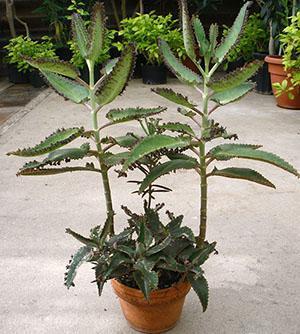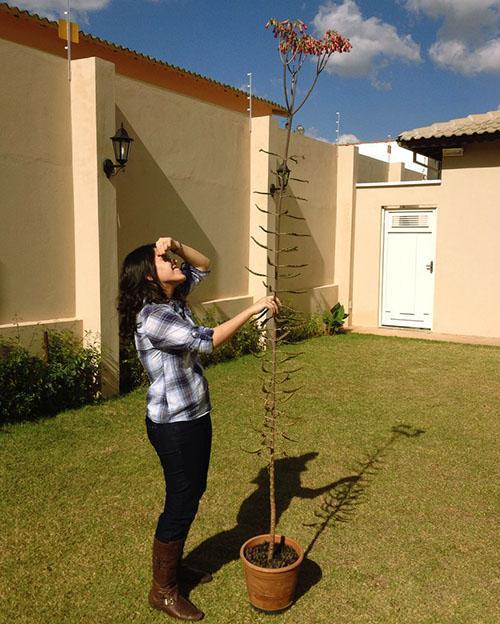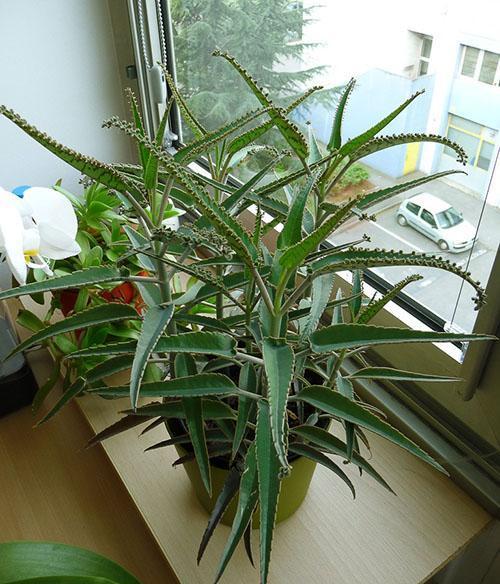Pharmacy on the windowsill - Kalanchoe Dergemona
 Pointed gray-green leaves and garlands of tiny "babies" on jagged edges. Such an image is most often born in the imagination when Kalanchoe is mentioned. Even without knowing the full name, people represent the Kalanchoe Degremona - the most common type of this indoor culture in our country.
Pointed gray-green leaves and garlands of tiny "babies" on jagged edges. Such an image is most often born in the imagination when Kalanchoe is mentioned. Even without knowing the full name, people represent the Kalanchoe Degremona - the most common type of this indoor culture in our country.
Description of Kalanchoe Degremon
This type of Kalanchoe is found naturally on the island of Madagascar and in the Cape region. In stony dry semi-deserts, wild plants can reach impressive sizes. The powerful erect stem of the Kalanchoe grows up to 2–4 meters in height under favorable conditions, and as it grows, the lower leaves fall off, and the stem gradually lignifies.

 In nature, this variety of Kalanchoe blooms regularly, laying buds during the period of shortening daylight hours. And pink-purple or brownish flowers that open in winter are collected in a large inflorescence, located on an elongated erect peduncle.
In nature, this variety of Kalanchoe blooms regularly, laying buds during the period of shortening daylight hours. And pink-purple or brownish flowers that open in winter are collected in a large inflorescence, located on an elongated erect peduncle.
The Kalanchoe Degremona gained fame for its record endurance and ability to reproduce, as well as for the long-established healing properties of the juice and pulp of the plant.
Read also the article: Kalanchoe - medicinal properties and contraindications!
The healing properties of Kalanchoe Degremon
The most famous medicinal product is the juice obtained from the juicy fleshy leaves of Kalanchoe.
 The juice of this plant and gruel from crushed leaves are used as an anti-inflammatory, hemostatic and wound healing agent. Kalanchoe Degremona exhibits these healing properties in all kinds of skin diseases, abrasions and difficult healing wounds. If you land Kalanchoe on garden bed suburban area, and in winter transplanted into a pot, there will be a great opportunity to use its healing properties all year round.
The juice of this plant and gruel from crushed leaves are used as an anti-inflammatory, hemostatic and wound healing agent. Kalanchoe Degremona exhibits these healing properties in all kinds of skin diseases, abrasions and difficult healing wounds. If you land Kalanchoe on garden bed suburban area, and in winter transplanted into a pot, there will be a great opportunity to use its healing properties all year round.
Fresh juice is a recognized natural remedy for sinusitis, acute and chronic rhinitis. In this case, Kalanchoe exhibits antimicrobial, soothing and disinfecting properties.
Official medicine fully supports and even develops folk experience. It has been proven that the Kalanchoe Degremona is used in the treatment of purulent inflammatory processes, in recovery after surgery, in dentistry and gynecology. Juice from fresh green leaves suppresses the activity of Staphylococcus aureus and streptococci.
Today biochemists are conducting research into the antiviral properties of plants, for example, against the influenza virus. The possibility of using the medicinal properties of Kalanchoe Degremon as a preparation for maintaining and strengthening immunity and general body resistance is being studied.
Kalanchoe care: photo and description of basic techniques
 It will not be difficult even for a novice florist to grow a Kalanchoe Degremon at home.A plant belonging to succulents is not for nothing considered a symbol of a unique ability to reproduce and survive. It is not demanding either on the soil or on the size of the pot, it is drought-resistant and can grow with a lack of light. But all these restrictions do not pass without leaving a trace for the Kalanchoe and are reflected in its appearance.
It will not be difficult even for a novice florist to grow a Kalanchoe Degremon at home.A plant belonging to succulents is not for nothing considered a symbol of a unique ability to reproduce and survive. It is not demanding either on the soil or on the size of the pot, it is drought-resistant and can grow with a lack of light. But all these restrictions do not pass without leaving a trace for the Kalanchoe and are reflected in its appearance.
With a lack of light, the shoots stretch out, the leaves, as with excessive soil poverty and rare watering, become thinner, become faded and sluggish.
What conditions and care is required for a plant, how to water a Kalanchoe in order to maintain its health and growth? Like many succulents, the Degremona Kalanchoe does not need a large pot and fertile soil. For planting a plant, it is better to take ready-made soil for succulents or cacti. It is light enough, loose and, which is important for this culture, does not retain much moisture, which can lead to root rot.
 If there is no ready-made soil, in equal parts you can mix turf soil, sand, rotted humus and crushed crumbs from gravel or brick. A drainage layer is required at the bottom of the pot. It is by creating the habitual conditions of existence for the Kalanchoe Degremon, as in the photo, that you can get the best results and even admire large inflorescences of elongated flowers.
If there is no ready-made soil, in equal parts you can mix turf soil, sand, rotted humus and crushed crumbs from gravel or brick. A drainage layer is required at the bottom of the pot. It is by creating the habitual conditions of existence for the Kalanchoe Degremon, as in the photo, that you can get the best results and even admire large inflorescences of elongated flowers.
Succulents, including Kalanchoe, are sensitive to temperature and light fluctuations.
In nature, in places where these plants are found, temperatures can reach 30 ° C during summer hours. At night, the air is cooled to 17–20 ° C. In indoor conditions, it is especially important to prevent the temperature from falling below 15 ° C and its long-term excess of 27 ° C. In winter, for the Kalanchoe Degremon, they find an illuminated place away from heating appliances and a possible draft, while watering cut so that the roots do not suffer from stagnant moisture.
 In summer, the bushes feel great on the balcony, veranda or garden. At this time, the Kalanchoe, on the contrary, needs more water, and with its lack it withers, the leaves sag and become noticeably thinner. In order not to be mistaken with watering, before watering the Kalanchoe, it is better to check the moisture content of the soil. If it is completely dry by one or two centimeters, then the water will benefit the plant.
In summer, the bushes feel great on the balcony, veranda or garden. At this time, the Kalanchoe, on the contrary, needs more water, and with its lack it withers, the leaves sag and become noticeably thinner. In order not to be mistaken with watering, before watering the Kalanchoe, it is better to check the moisture content of the soil. If it is completely dry by one or two centimeters, then the water will benefit the plant.
Kalanchoe loves and tolerates bright lighting, except for the scorching direct rays of the sun, from which the bushes will have to be shaded.
 To stimulate flowering, as in the photo, Kalanchoe care includes such a procedure as artificial limitation of the duration of daylight hours. If the bush is on a light windowsill only from 8 to 10 hours a day, buds are laid on the tops of the shoots. Before flowering, Kalanchoe can be fed several times using a mixture for flower crops or succulents, and also ensure proper watering and care.
To stimulate flowering, as in the photo, Kalanchoe care includes such a procedure as artificial limitation of the duration of daylight hours. If the bush is on a light windowsill only from 8 to 10 hours a day, buds are laid on the tops of the shoots. Before flowering, Kalanchoe can be fed several times using a mixture for flower crops or succulents, and also ensure proper watering and care.
After flowering, a period begins when the plant recovers within a month, and then gives an increase in leaves and shoots.
At this time, not only dried peduncles are removed, but also overgrown and exposed shoots are pruned, the tops of which can be used at home for reproduction of Kalanchoe.
How to propagate Kalanchoe at home?
 Very unpretentious, perennial Kalanchoe Degremona is famous for many ways and ease of reproduction. You can get a new bush with the help of stem cuttings and leaves, cuttings and numerous children, literally strewn with the edges of the leaves of adult plants. Before propagating Kalanchoe at home using cuttings, from a plant:
Very unpretentious, perennial Kalanchoe Degremona is famous for many ways and ease of reproduction. You can get a new bush with the help of stem cuttings and leaves, cuttings and numerous children, literally strewn with the edges of the leaves of adult plants. Before propagating Kalanchoe at home using cuttings, from a plant:
- with a sharp knife or blade, cut off the top of a healthy shoot;
- manually, fingers carefully separate the lateral shoot in the leaf axil.
 If such a shoot has aerial roots, this will only simplify rooting. Then the lower leaves are removed from the cutting and left for a day to dry the cut site.The finished shoot is placed in wet sand or substrate to a depth of 3-5 cm, and it is not necessary to use a temporary container. Kalanchoe Degremona takes root well, and the cuttings can be immediately planted in a permanent pot intended for them. The soil around the new plant is compacted, and after 7–10 days at a temperature of 20–25 ° C.
If such a shoot has aerial roots, this will only simplify rooting. Then the lower leaves are removed from the cutting and left for a day to dry the cut site.The finished shoot is placed in wet sand or substrate to a depth of 3-5 cm, and it is not necessary to use a temporary container. Kalanchoe Degremona takes root well, and the cuttings can be immediately planted in a permanent pot intended for them. The soil around the new plant is compacted, and after 7–10 days at a temperature of 20–25 ° C.
Caring for Kalanchoe from the moment of planting consists only in timely watering.
 It is no more difficult to get a plant from a tiny baby. Often, falling, such rosettes take root on their own and form a friendly "undergrowth" under an adult Kalanchoe. Therefore, they can be immediately planted in permanent pots. And when the young growth reaches 15–20 cm in height, the Kalanchoe Degremona pinch the crown, in this way causing branching and the formation of a compact, convenient bush for growing.
It is no more difficult to get a plant from a tiny baby. Often, falling, such rosettes take root on their own and form a friendly "undergrowth" under an adult Kalanchoe. Therefore, they can be immediately planted in permanent pots. And when the young growth reaches 15–20 cm in height, the Kalanchoe Degremona pinch the crown, in this way causing branching and the formation of a compact, convenient bush for growing.